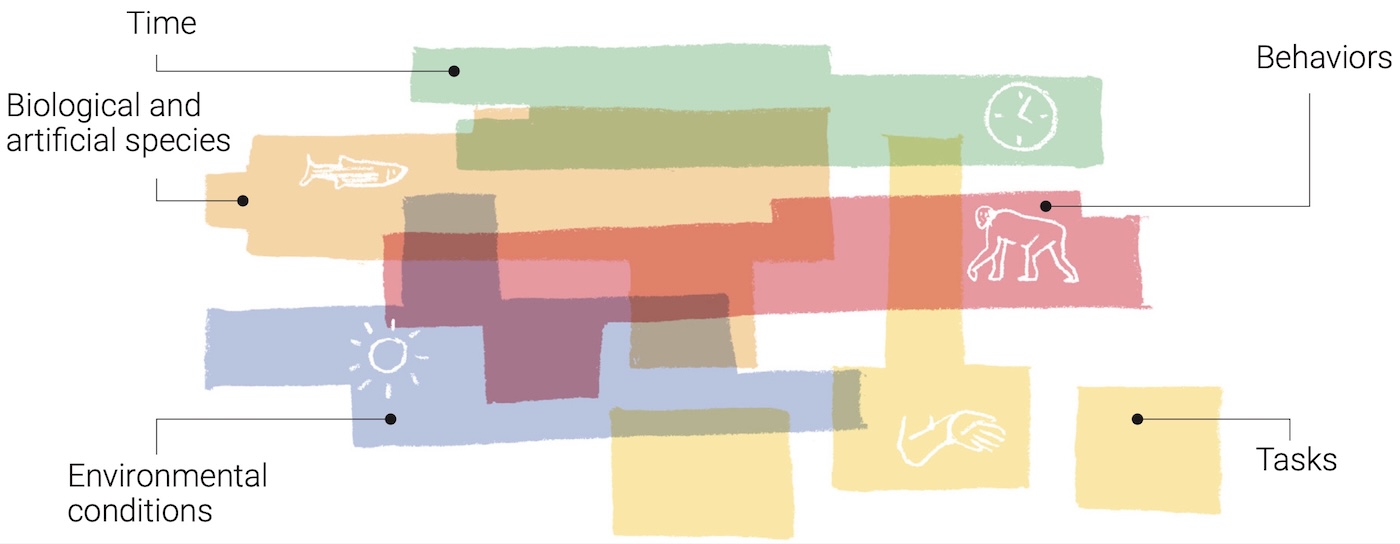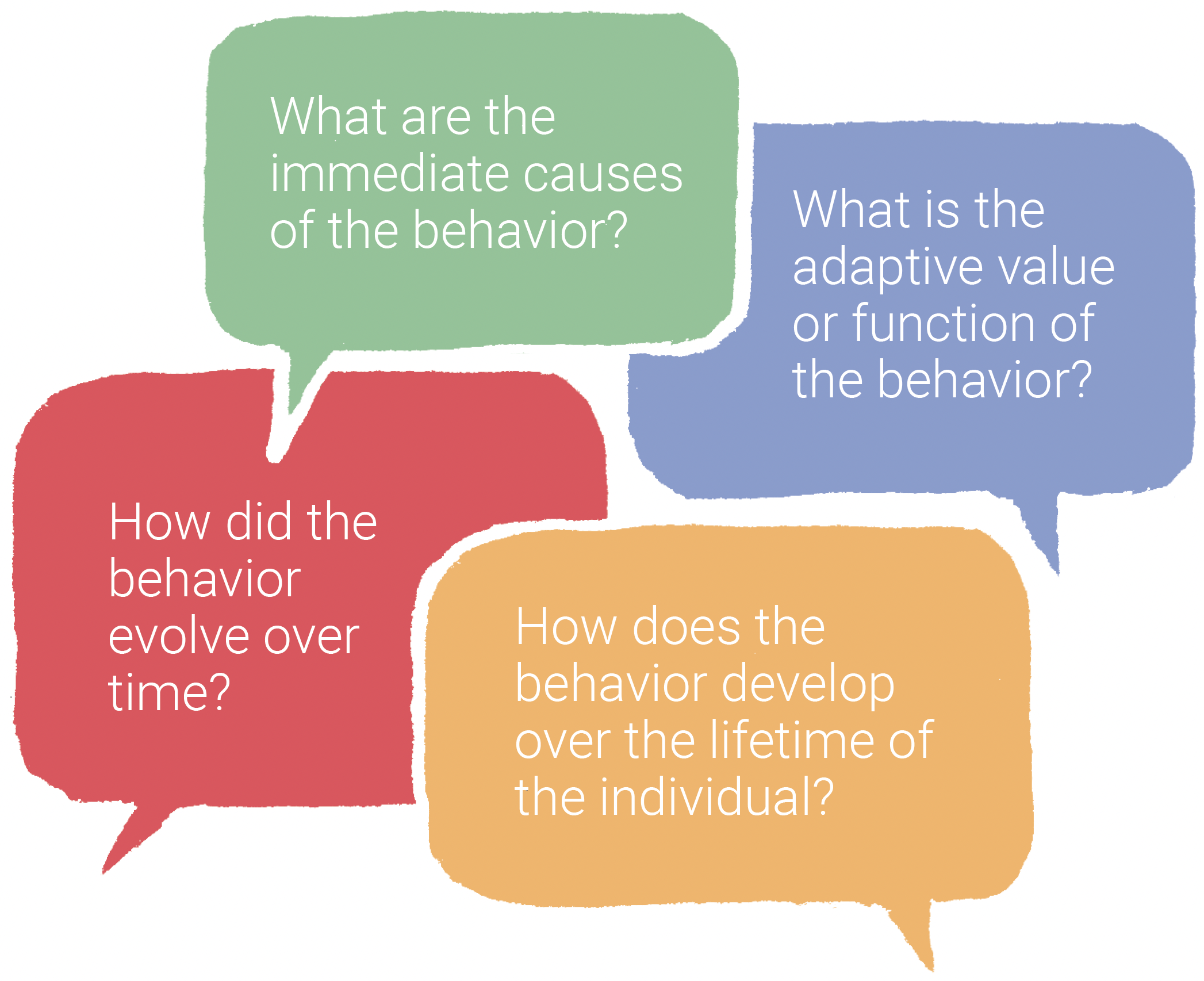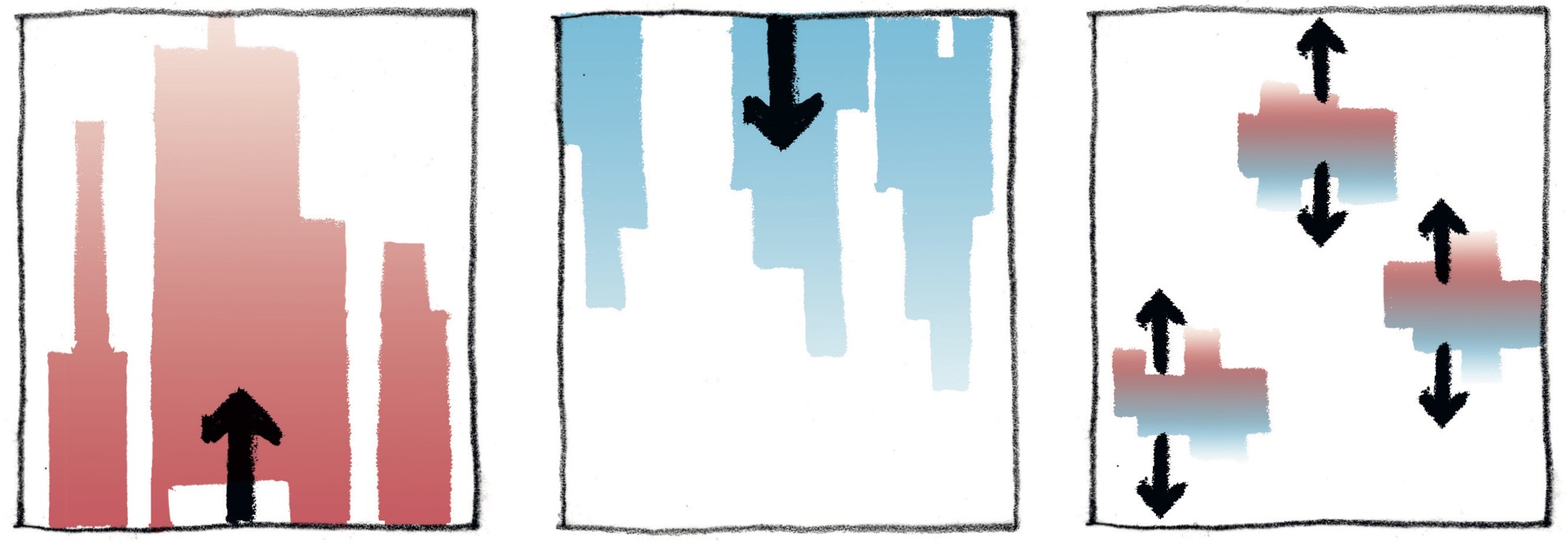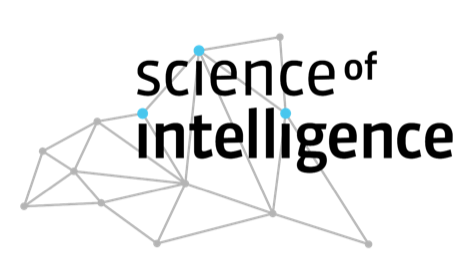Characterizing biological and artificial intelligence
We discussed how principles help identify islands of structure. We also explained how, starting from these islands, we can explore the hypothesis space about intelligence. We now turn to the question of how to use principles in explaining intelligence. What would such a principle-based characterization of intelligence look like?

Figure 5: Illustration of how biological intelligence has evolved in a conceptual space spanned by the principles of intelligence
To characterize intelligence based on principles, we must be able to separate intelligence from non-intelligence. We must also be able to articulate why this boundary exists and what the characteristics are that give rise to that boundary. To illustrate this, we imagine a space whose dimensions span the characteristics of systems, i.e., the principles implemented in the system. In Figure 5 , this space is drawn in the horizontal plane. There are certainly many dimensions/principles required to characterize any kind of intelligent system. But since this is a thought experiment and we merely care about illustrating the concept, we content ourselves with only two dimensions, labeled “Principles” in the figure. Additional axes indicate that there are actually many more dimensions. Any imaginable intelligent system now corresponds to a point in this space, whose coordinates are sufficient to specify the system in its entirety.
Let us first look at biological systems, illustrated as the green, coral-like structures in Figure 5. These systems evolved over long time scales (the vertical axis). We consider the period between today and a point t=0 in the past at which intelligent systems already existed.
Consider the slice t=0 of the space shown in Figure 5. There are five green regions, indicating parts of the design space in which intelligent systems existed in biology. We refer to these regions as species, being fully aware that the notion of species in biology is disputed (Hey et al., 2003). Within SCIoI, a species is a set of system designs sharing fundamental characteristics that differentiate it from other designs.
As evolution progresses along the vertical time axis, these regions can change their shape or move in the plane. These changes represent changes in system design, either as a response to changing environmental conditions or as an adaptation to the ecological niche. There can be convergence and divergence events. Convergence corresponds to several species beginning to share the fundamental system traits relevant for intelligence because of evolutionary pressures. Divergence corresponds to a species separating into two different system designs to occupy different ecological niches. This evolution of the green regions gives rise to the green “trunks” that capture the evolution of intelligent systems over time.
Our goal is to characterize relevant regions of system designs, such as the green trunks, using principles of intelligence. The differentiation between different trunks arises from the set of principles being different for each of them. This implies that principles of intelligence are not universal. They are beneficial in specific ecological niches and therefore characterize the system designs capable of establishing themselves in those niches.

Figure 6: Illustration of how biological and artificial systems can be characterized in the same conceptual space
Figure 6 includes artificial systems. Like biological ones, they are characterized by the principles they realize. These principles separate AI systems into “species.” This way of characterizing AI systems leads to explainability, because we can explain the system’s behavior based on the principles.
Figure 6 shows that biological and artificial species can occupy an overlapping conceptual space. This corresponds to them addressing overlapping ecological niches with an overlapping set of principles. But artificial species are not bound to the process of evolution—we can design artificial systems to deliberately explore the design space beyond biological examples. The inclusion of artificial systems thus provides SCIoI with an important opportunity to gain insight into principles not yet discovered by biological processes.
A variety of biological and artificial species
 Figure 7: Variety of biological and artificial species in SCIoI
Figure 7: Variety of biological and artificial species in SCIoI
For a large number of problems there will be some species of choice, or a few such species, on which it can be most conveniently studied.
(adapted from Krogh’s Principle Krogh, 1929)
This idea, originally formulated by Claude Bernard (Bernard, 1865), is central to our comparative approach to intelligence research. Our ability to gain insights into intelligence will be greatly accelerated by an appropriate selection of species to study, either biological or artificial. To support a broad research agenda, the PIs and collaborators of SCIoI have experience with and access to the following 14 biological and 12 artificial “species templates” (because the species are not fully specified yet).
Mammals: Humans (Abdel Rahman, Brass, Hanning, Haynes, Hertwig, Haun, Kurvers, Lazarides, Liebal, Onnasch, Rolfs, Wiese); nonhuman great apes: chimpanzees, bonobos, gorillas, orangutans (Haun, Liebal); pigs (Eusemann, Haun, Liebal, Thöne-Reineke); mice (Lewejohann, Sprekeler, Thöne-Reineke)
Birds: Cockatoos (Auersperg (external PI), Brock, Kacelnik); fish-eating birds (Krause, Romanczuk); chickens (Eusemann, Thöne-Reineke)
Fishes: Clonal Amazon mollies, sulphur mollies, Trinidadian guppies (Krause, Romanczuk)
Insects: Honeybees (Landgraf, Lewejohann)
Robots: Nao humanoid robots (Hafner); Pepper humanoid robots (Hafner); mobile manipulators (Brock, Toussaint); soft robots (Brock); Kilobots swarming robots (Romanczuk); Thymio II wheeled robots (Romanczuk); Robofish (Krause, Landgraf)
LLMs: ChatGPT-style decoder models (Akbik); BERT-style encoder models (Akbik); PaLM-E-style models (Toussaint); multimodal models (Brock)
Reinforcement learning agents (Akbik, Brock, Hafner, Romanczuk, Toussaint)
This diversity in artificial and biological species will enable researchers in SCIoI to follow Krogh’s principle, picking the model systems most suitable for the question at hand. This diversity in model systems will also facilitate identifying the constraints that lead us to the islands of structure illustrated in Figure 1.
Summary of main methodological advances in SCIoI
The definition of principles of intelligence provides a new methodological focus. While we so far could only speculate about principles, we now have aligned the research program with our new insights and resulting implications. The revised methodology has already proven to be highly effective.
Given the explosive progress in AI, we have now included a branch of the research program dedicated to AI systems, enabling us to leverage these recent developments. Here, we consider AI systems to be instances of artificial species, analogous to biological ones.
Given the new branch investigating artificial species, we will intensify our efforts to apply analytic methods to artificial systems. AI systems have become so complex that studying their behavior becomes challenging. SCIoI’s methodology, with its synthetic approach and the analytic/synthetic loop, is well-suited to addressing this challenge.
The comparative approach with its many different dimensions is now an integral part of our methodology, significantly expanding the opportunities for insight into intelligent behavior and the principles that produce it.
We have approximately doubled the number of biological species in our investigations, expanding our opportunities for discovery within the comparative approach.
Our methodology now explicitly includes the temporal component of Tinbergen’s four questions, meaning that we now fully cover all levels of analysis for behavior. This is supported by the new PIs from Leipzig who have the relevant expertise (Eusemann, Liebal, Haun).
Given our understanding of principles of intelligence, we have improved our ability to devise principle-driven engineering practices for engineering intelligent systems.
The insights obtained so far and the resulting methodological advances described here enable us to address higher-level cognitive functions and more complex intelligent behaviors. While the focus has so far been on relatively low-level behaviors, our research program now includes projects on higher-level cognitive functions, for example, on metacognition and theory of mind (ToM).
A historical note on SCIoI and the cognitive revolution
SCIoI’s research methodology follows the tradition of the cognitive revolution which lead to the founding of cognitive science (Miller, 1956). This revolution produced a shift in focus from the characterization of behavior to the characterization of the inner workings of the mind. SCIoI advances the field of intelligence research much more comprehensively. Rather than attempting to identify the architecture of a single cognitive system (the human mind), SCIoI seeks to characterize intelligence as a whole in its entirety. At first, this sounds much more challenging. We contend that it leads to a significant simplification and disruptive progress. By raising the level of abstraction of the overarching question and by broadening the perspective across all forms of intelligence and levels of abstraction, we can gather more and diverse evidences more easily across different species and contexts. This makes it much easier to identify relevant patterns, corresponding to candidate principles of intelligence. Moreover, SCIoI’s methodology carefully distinguishes between descriptive models of behavior in the tradition of cognitive science and psychology, and truly mechanistic models that generalize. These aspects are all embedded into SCIoI’s research methodology. The resulting shift in scientific approach brings about fundamental progress, as we have demonstrated so far.
Positioning within the research area
Positioning with respect to disciplines
Cognitive science: SCIoI shares with cognitive science the goal of understanding cognition and intelligence based on an interdisciplinary research program. The conceptual foundations of cognitive science remain valid in SCIoI, as described earlier when we discussed the cognitive revolution. However, cognitive science did not develop into a separate discipline, as initially intended. Instead, it retained a substantial overlap with psychology. Núñez et al. (2019) determined that most papers are authored by psychologists and cite mostly other psychology papers. Faculty members are mostly psychologists by training, and most courses taught in cognitive science departments are psychology courses. In contrast, SCIoI is building a new scientific discipline from a cohesive research project with a set of PIs working together in a single location on joint projects using a shared infrastructure. SCIoI generates a deep conceptual collaboration between the involved disciplines, as evidenced by the data in Figure 9. The substantial progress made in SCIoI toward understanding intelligence and cognition validates our methodological approach to a unified science of intelligence.
Artificial Intelligence: SCIoI is also a science of Artificial Intelligence (AI). AI has reached a level of complexity that makes it nearly impossible to fully understand AI systems, given methods available in AI today. We respond to this challenge by applying SCIoI’s methodology to artificial systems as well: SCIoI investigates the principles of intelligence shared by all forms of intelligence, both artificial and biological. In that sense, AI systems are model systems in SCIoI, similar to biological species. SCIoI will study state-of-the-art AI systems, in conjunction with biological intelligent systems, to identify the shared principles of intelligence.
The transformative developments in AI technology are undeniable. They already play a key role in SCIoI. Our research leverages these technological advances in many ways. Our team includes three PIs who develop this technology (Akbik, Brock, Toussaint) and many are applying it (Akbik, Brock, Lewejohann, Romanczuk, Sprekeler, Toussaint).
SCIoI aims to develop an approach to artificial intelligence that is fundamentally different from today’s deep learning foundation models. This is urgently needed: Researchers have estimated that biological intelligence is six orders of magnitude more energy- and data-efficient than today’s AIs (Smirnova et al., 2023). In addition, the need for exponential amounts of data remains a barrier for progress (Udandarao et al., 2024).
There are also strategic reasons for Germany and for Europe to invest in alternative approaches to AI. Currently, among the top 15 organizations training foundation models, not one is based in Europe (Maslej et al., 2024, Figure 1.3.17, page 60). Two foundation models are from Germany, compared to 102 from the United States of America and 20 from China (Maslej et al., 2024, Figure 1.3.18, page 61). The technology is owned and dominated by large American corporations (Google, Meta, Microsoft, OpenAI) (Maslej et al., 2024, Figure 1.3.17, page 60). If successful, an alternative approach to AI would enable Germany and Europe to leapfrog such developments and establish itself as a leader in AI.
The cost of training large AI models is skyrocketing. It increased from 12 million US$ for PaLM in 2022 to almost 200 million US$ for Gemini Ultra in 2023 (Maslej et al., 2024, Figure 1.3.21, page 64), making the technology accessible to only a few. The financial cost is largely caused by enormous electricity requirements and therefore translates into CO2 emissions. An alternative, energy-efficient approach to AI, such as the one developed in SCIoI, might contribute to democratizing the technology and reducing its impact on climate change.
AI is liable to be the most transformative technology invented by humans. There should be several alternative and complementary paradigms to support this transformation. AI technology developed in SCIoI can ensure that this transformation is sustainable and safe. SCIoI’s conceptual approach to intelligence can enable AI systems to show the abilities currently exclusive to biological systems, like generality, autonomy, and versatility. In addition, the resulting technology promises to exhibit the advantageous performance parameters of biological systems, such as very low energy consumption and low data requirements. The technology enabled by SCIoI will also be explainable, increasing the transparency and auditability of AI technology.
Computational, behavioral, and general biology: By studying intelligence as a complex phenomenon exhibited by biological agents, SCIoI naturally has strong overlaps to sub-fields of biology concerned with observing, analyzing, and modeling behavior. Experimental research within SCIoI employs methods from behavioral biology, psychology, and neuroscience, potentially adapting and advancing them for the purpose of investigating principles of intelligence.
The comparative approach, which will take center stage as a methodological tool in SCIoI, already plays a key role in evolutionary biology. Its scope in SCIoI extends beyond the typical usage in biology by explicitly including artificial “species” as objects of comparison, and by explicitly comparing the role of principles of intelligence across different scales in multi-level systems. And so, within SCIoI, Darwinian evolution is only one context for comparison, besides cultural evolution, or the diversity emerging from the technological innovation in AI.
Computational models of behavior from biology often serve as a starting point for corresponding modeling within SCIoI (see e.g., Klamser and Romanczuk (2021); Gomez-Nava et al. (2023)). However, SCIoI is mainly concerned with identifying mechanistic models of behavior at the right level of abstraction, capturing the regularities of relevance for intelligent behavior. Therefore, we are not concerned with statistical models as for example employed in bioinformatics (Ewens et al., 2005), and the level of description differs significantly from modeling approaches established in biology, such as those focusing on biomolecular (Mogilner et al., 2006) mechanisms (Hastings, 2013) or (adaptive) dynamics at the level of populations . Finally, based on the study of principles of intelligence, one aim of SCIoI is to propose new mechanistic models of behavior, which we expect will be highly relevant for disciplinary research in biology (Lang et al., 2023).
A central objective of SCIoI is the development of a new scientific community which performs across traditional disciplines, including biology. Through identifying and investigating general principles of intelligence and how they underlie the generation of behavior, SCIoI will provide the basis for testing the implementation of these principles in other biological systems like plants or bacteria that have been argued to exhibit aspects of intelligence (Jacob et al., 2004; Trewavas, 2003). In consequence, SCIoI research will establish new links to other sub-fields of biology not yet represented in SCIoI so far, such as plant biology or microbiology.
Complex systems, applied mathematics, and statistical physics: The field of complex systems spans many disciplines, including applied mathematics or statistical physics. It focuses on understanding mechanisms of self-organization and the emergence of complex structures and dynamical patterns from the interaction of many components or agents. It often relies on complex networks as a framework for describing such systems (Boccaletti et al., 2006).
The range of real-world systems motivating research on complex systems is quite broad. The discipline includes fundamental research into the origin of structure in physics and biology (Haken, 2006), the study of complex dynamics of social networks (Vega-Redondo, 2007), the scaling of cities (Bettencourt, 2013), and even cosmological patterns (Krioukov et al., 2012). Typically, it remains a theoretical science, primarily aimed at explaining dynamical patterns exhibited by different classes of complex systems, identifying universal laws or scaling relationships in these systems, and not aiming to uncover principles underlying the generation of adaptive, intelligent behavior in biological and artificial systems.
When analyzing and modeling intelligent, distributed, or collective systems, SCIoI relies on similar methods as complex systems research, such as adaptive network models (Poel et al.,
2022). Despite methodological overlaps, by bringing together experimental and theoretical researchers to uncover principles of intelligence and by investigating functional implications of the observed self-organized dynamics for intelligent behavior, SCIoI distinguishes itself from the larger, more diffuse field of complex systems.
Positioning with respect to research centers
The Center for Brains, Minds and Machines (CBMM) and the Quest for Intelligence at the Massachusetts Institute of Technology (MIT) are networks of researchers across analytic and synthetic disciplines of intelligence research. While they provide a platform to interact across disciplines, they do not define a shared research strategy or specific joint projects. The focus on neuroscience, in contrast to SCIoI’s focus on behavior and mechanistic characterizations of intelligence, represents fundamental methodological differences from SCIoI.
Similarly, the Leverhulme Centre for the Future of Intelligence (LCFI) is a center connecting interdisciplinary researchers within the University of Cambridge. The activities within the center address the challenges and opportunities of AI. There is less emphasis on intelligence as a biological phenomenon. However, the research thread Kinds of Intelligence raises questions also addressed by SCIoI. The research approach of LCFI is focused on cognitive sciences and philosophy. In contrast to SCIoI, they do not target a mechanistic understanding of intelligence and lack the synthetic approach.
The Santa Fe Institute (SFI) has several research themes related to SCIoI’s approach, including Complex Intelligence and Invention & Innovation. However, the specific research foci differ from SCIoI. SFI focuses on human social and hybrid human-AI systems on a larger scale and on a theory-minded, complex systems approach to intelligence and computation. Further, SFI’s structure is quite different from that of SCIoI. It hosts a small number of core faculty, and a larger number of external faculty, that form a rather loose community.
The Alan Turing Institute performs research in data science, AI, machine learning, and data engineering. It focuses on applications in the public sector (national security, environment, health). Its agenda is not directed toward a basic science of intelligence. Biological intelligence and the analytic approach are not represented.
The Berlin Institute for the Foundations of Learning and Data (BIFOLD) is dedicated to research in big data management and machine learning. The focus of BIFOLD is to develop these technologies for application in industry and the natural sciences. Its target is not a basic science of intelligence itself, and it lacks the consideration of biological intelligence and the analytic approach. BIFOLD is co-located with SCIoI in Berlin and complementary in its approach to AI. SCIoI cooperates with BIFOLD.
The Machine Learning for Science Cluster at Universität Tübingen focuses on applying machine learning methods to other sciences, such as physics, medicine, chemistry, and climate research. Its goal is therefore not a basic science of intelligence itself. Biological intelligence and the analytic approach are not represented.
Hessian.AI focuses on modern AI technologies (the “Third Wave of AI”), basic AI research, its transfer to industry, and its impact on society. The target of Hessian.AI is not the basic science of intelligence itself; it lacks considerations of biological intelligence and the analytic approach.



 Figure 4: Different modeling approaches in intelligence research: The top layer of the figure represents complex phenomena with complex context; the bottom layer represents elementary, more isolated phenomena. Arrows indicate top-down modeling (blue) and bottom-up modeling (red). Shading indicates the amount of evidence supporting a model, with light colors indicating less evidence. The width of the colored region represents the generality of a model. To discover principles of intelligence, SCIoI will continue performing bottom-up research, i.e., studying specific phenomena under well-controlled conditions (panel-left). We will also perform top-down research to reflect the weak decomposability of intelligent systems (panel-middle). The formulation of candidate principles at intermediate levels of abstraction also enables a third approach, called middle-out (panel-right), in which hypothesized islands of structure serve as starting points for local top-down and bottom-up investigations, pushing outwards from points in the middle (panel-right). This offers a new way to discover islands of structure. As we cover the phenomenological space associated with intelligence incrementally, we build a complete understanding of intelligence.
Figure 4: Different modeling approaches in intelligence research: The top layer of the figure represents complex phenomena with complex context; the bottom layer represents elementary, more isolated phenomena. Arrows indicate top-down modeling (blue) and bottom-up modeling (red). Shading indicates the amount of evidence supporting a model, with light colors indicating less evidence. The width of the colored region represents the generality of a model. To discover principles of intelligence, SCIoI will continue performing bottom-up research, i.e., studying specific phenomena under well-controlled conditions (panel-left). We will also perform top-down research to reflect the weak decomposability of intelligent systems (panel-middle). The formulation of candidate principles at intermediate levels of abstraction also enables a third approach, called middle-out (panel-right), in which hypothesized islands of structure serve as starting points for local top-down and bottom-up investigations, pushing outwards from points in the middle (panel-right). This offers a new way to discover islands of structure. As we cover the phenomenological space associated with intelligence incrementally, we build a complete understanding of intelligence. 

 Figure 7: Variety of biological and artificial species in SCIoI
Figure 7: Variety of biological and artificial species in SCIoI



